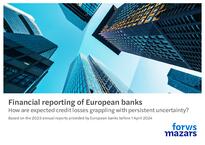Does the perceived reduction in risk amongst European banks hint at early signs of optimism for the sector? Throughout 2023, we observed a global economic slowdown, ongoing geopolitical tensions, and the rapid rise of new technologies. As we analyse the year-end results of the 26 largest banks in Europe, what do these figures reveal about expected credit losses and how these institutions manage persistent uncertainties in the banking landscape?
We have analysed the 2023 year-end reports of 26 banks in 12 European countries to understand better the impact of financial turbulence and ongoing geopolitical crises on their Expected Credit Losses. This study is the eighth in its series and follows from previous editions of the report since its launch in 2020.
A focus on Expected Credit Losses
- The study mainly focuses on the ECL-related impacts, with key findings on:
- ECL charge impact of YE 2023 on the profit or loss and ECL allowances
- ECL allowances: changes in coverage ratios and allocation between stages
- Post-model adjustments/overlays
- Forward-looking information
Document
Financial reporting of European banks- benchmark study 2024

How has the financial performance of European banks fared amidst economic turbulence in recent years? Global inflation ensuing the war in Ukraine and the aftermath of the Covid-19 crisis have collectively affected the financial services industry, undoubtedly impacting the expected credit losses (ECL) in banks’ financial disclosures.

Finance is undergoing some of the most important changes in its history. The economic situation, globalisation, regulatory pressures and new technologies are contributing significantly to the transformation of the banking sector and the emergence of new players.






